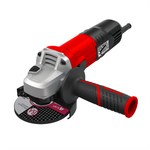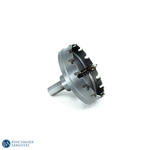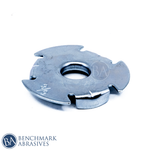
How To Reduce Heat And Friction When Using Cutting Tools

Any cutting tool application will produce heat, but you can extend the tool's life by learning how to mitigate it. Although it's not necessary to completely avoid heat, it can be beneficial, and managing heat will help your tool last longer. The heated tool or a workpiece can be identified easily by watching smoke and deformation. In other conditions, the signs are less clear. By redirecting heat as much as possible, you can enhance the tool's lifespan, prevent parts from being scrapped, and save a significant amount of money.
We'll go over every detail in this blog post on how to use cutting tools with less heat and friction.
Techniques To Reduce Heat and Friction When Using Cutting Tools
Here are some essential techniques for reducing heat and friction while using cutting tools:
1. Enhance The Cutting Parameters
enhancing or optimizing cutting parameters is essential for achieving accurate and effective machining outcomes. The process includes carefully choosing the right cutting speed, feed rate, and depth of cut for the particular material and tool being used.
- Cutting speed: Cutting speed is a crucial factor in machining operations or achieving optimal results. If the cutting speed is too high, it generates excessive heat and can cause wear or breakage. On the other hand, if the cutting speed is too slow, this results in increased cutting forces and inefficient material removal. The right cutting speed is totally based on factors like the type of tool, the material, and the required surface finish.
- Feed Rate: High feed rates can minimize friction by reducing the contact time between the tool and the workpiece. However, high feed rates can cause tool breakage and increased cutting pressures. Low feed rates, on the other hand, increase cycle times and may result in inefficient machining.
- Depth of a cut: it refers to the amount of material removed in a single pass of the cutting tool. By increasing the depth of cut, we can reduce the overall machining time, which will result in quick material removal and enhanced efficiency. Apart from its advantages, too large a depth of cut can result in increased cutting forces, excessive heat generation, and even damage to tools.
2. Selecting The Right Cutting Tools
Selecting the right cutting tools plays a crucial role in reducing heat and friction while using cutting tools. This includes Tool material, coatings, and tool geometry.
- Tool Material: Cutting tool material can also help reduce friction and heat when using cutting tools. Be sure to choose tools that are made from high-hardness and wear-resistant materials, including ceramic, carbide, and coated tools. These materials are well-known for reducing friction and can withstand high temperatures easily.
- Tool Geometry: This refers to the tool’s shape and configuration of the cutting edge and surrounding tool surfaces, including things like rake angle, cutting edge angle, nose radius, and clearance angle. Ensure to use tools with a positive rake angle to minimize cutting forces and friction.
- Coatings: ensure to make use of coatings like aluminum titanium nitride for cutting tools. These coatings act as a barrier and help reduce friction and heat, improve wear resistance, and enhance the tool’s durability.
3. Apply Effective Cooling And Lubrication
Applying effective cooling and lubrication is also essential in reducing friction and heat when using cutting tools. The friction produced during the cutting process generates heat, which can cause damage to the tool and the workpiece.
- Cutting Fluids: Cooling is usually achieved by using cutting fluids, which helps dissipate heat and reduces tool wear, workpiece distortion, and poor surface finish. Cutting fluids also offer lubrication, which helps reduce friction between the workpiece and the tool, minimize cutting forces, and prevent chip welding.
- Coolant Application: always ensure the proper coolant is delivered to the cutting zone, which can help reduce friction and dissipate heat. Some of the methods used for coolant delivery include flood cooling. It is the most popular method, which includes directing a large amount of water or coolant over the tool and workpiece, which results in heat dissipation and removal of the chip. Another popular method is mist cooling; it uses a fine spray of coolant mixed with air and is mostly preferred for situations where flood cooling is impossible. Tool cooling is another method in which the coolant is delivered via channels within the cutting tools itself. This method works best for deep-hole drilling and operations where it is impossible to reach the cutting zone. Applying coolant optimally guarantees effective heat dissipation, reduces friction, and enhances tool life and workpiece quality.
4. Regular Maintenance And Tool Sharpening
Regular maintenance and sharpening of tools are essential in reducing heat and friction while using cutting tools. Be sure to examine the tool for any wear and tear or damage. Damaged tools generate more heat and friction during the cutting process and result in severe damage to the tool or workpiece. Therefore, regular maintenance is necessary to prevent friction and heat during the cutting process. Tool sharpening is another crucial factor to consider. By doing this, you can minimize the risk of severe damage.
5. Vibration Control
In order to prevent heat generation and friction, vibration control is the key. Overly strong vibrations cause the cutting tool and workpiece to come into sporadic contact, which increases friction and causes localized heat buildup. Chips may also be unable to flow smoothly due to this sporadic contact, which could lead to built-up edges or welding to the cutting tool. In both of these cases, friction is significantly increased, and additional heat is produced. By reducing vibrations, the cutting process becomes more consistent and stable. It further ensures smoother chip flow and minimizes cutting forces and heat dissipation.
By following these techniques, you can significantly reduce friction and minimize heat generation, which helps enhance the tool’s lifespan and provides a smooth and even surface finish.



































































